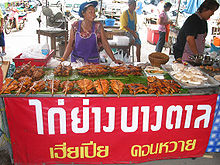This article includes a list of general references, but it lacks sufficient corresponding inline citations. (February 2013) |
 Kai yang at the old market of Don Wai, Nakhon Pathom | |
| Region or state | Southeast Asia |
|---|---|
| Associated cuisine | Lao, Thai |


Kai yang or gai yang (Thai: ไก่ย่าง, pronounced [kàj jâːŋ], lit. 'grilled chicken'), also known as kai ping or gai ping (Thai: ไก่ปิ้ง), or pīng kai (Lao: ປີ້ງໄກ່, [pîːŋ kāj]), is a Lao dish originating in Laos and Thailand, but it is now commonly eaten throughout the whole of Thailand.[1][2][3] The dish is a standard staple of street markets and readily available at all times. Some regions of Laos become popular because of their flavorful and tender Ping Kai prepared using unique ingredients for marinating and techniques for grilling the meats.[4] Being a typical Laotian dish, it is often paired with green papaya salad and sticky rice (Thai/Isan: ข้าวเหนียว, pronounced [kʰâ(ː)w.nǐaw]; Lao: ເຂົ້າໜຽວ, pronounced [kʰȁ(ː)w.nǐaw]) or eaten with sticky rice in bamboo (khao lam in Lao). It is also eaten with raw vegetables, and often dipped in spicy sauces such as Laotian jaew bong.[1]
In Thailand, there are also many famous Thai Muslim varieties of kai yang which are not of Lao origin at all, but more akin to the grilled chicken from Malaysia.[citation needed]
- ^ a b "Traditional Lao Barbecue In Luang Prabang". 10 September 2023.
- ^ "PING GAI (LAOTIAN GRILLED CHICKEN)". n.d.
- ^ Vera Abit-bol (n.d.). "PING KAI".
- ^ "Savannakhet's Famous Xeno Grilled Chicken Now in Vientiane". 7 August 2016.